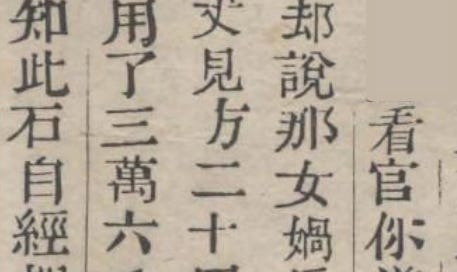The Discarded Stone
Most translations treat this passage as the proper beginning of Dream of the Red Chamber. The passage refers to the mythological legend of Nüwa using stones to repair the heavens – but then describes an unused stone that wound up being discarded.
Chinese Text
看官!你道此書從何而起?說來雖近荒唐,細玩頗有趣味。
卻說那女媧氏煉石補天之時,於大荒山無稽崖煉成高十二丈、見方二十四丈大的頑石三萬六千五百零一塊。那媧皇只用了三萬六千五百塊,單單剩下一塊未用,棄在青埂峰下。誰知此石自經鍛鍊之後,靈性已通,自去自來,可大可小。因見眾石俱得補天,獨自己無才,不得入選,遂自怨自愧,日夜悲哀。
Translation Notes
看官 means “dear reader.”
你道 is short for 你知道(嗎)and is clearly a question here based on the context. You can still hear 你道 in modern colloquial Chinese spoken in northeast China.
細玩 stands for 仔細玩味, which means to carefully ponder or consider.
大荒山 is actually the name of a mountain in northeast China, near Baekdu Mountain, the famous mountain of Korean mythology. See here for more information. Of course, that’s not the mountain referred to here. In this context, 大荒山 and 無稽崖 likely are a metaphorical reference to the fictional nature of the work, as explained in this helpful blog post.
丈 is the same as 10 尺 in classical Chinese. One 尺 was made equal to 1/3 meter in 1984, which means that a 丈 is 3 1/3 meters. You’re looking at 40 meters tall and 80 meters “square,” whatever “square” is supposed to refer to. These weren’t just little stones – these would have been absolutely huge stones.
青埂峰, usually translated as something like “Blue Ridge Peak,” is a homophone of 情根峰, “The Peak of the Roots of Love.” The stone is placed where love takes root. Some commentators think that this fact foreshadows an eventual romance between Jia Baoyu and Lin Daiyu; see this article for example. I don’t agree with that poster’s conclusions, though I suppose you can judge for yourself.
Translation Critique
Hawkes
Keep reading with a 7-day free trial
Subscribe to Dream of the Red Chamber to keep reading this post and get 7 days of free access to the full post archives.






